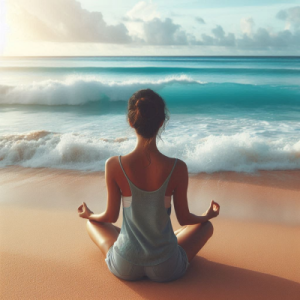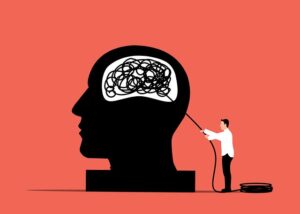Imagine a ship sailing through turbulent waters, seeking a moment of stillness amidst the storm. Within the chaos of daily life, finding instant calm can be like discovering a hidden oasis.
What if you could reveal the secrets to tranquility with simple yet powerful techniques at your disposal? Let’s explore practical methods that can anchor you in serenity and help you weather life’s storms with grace.
Deep Breathing Techniques
 To quickly achieve a sense of calm, practice deep breathing techniques that focus on slow and deliberate inhales and exhales. Deep breathing exercises are powerful relaxation techniques that can help you combat stress and anxiety effectively. By taking slow, deep breaths, you signal to your body to relax, activating the parasympathetic nervous system and reducing the production of stress hormones like cortisol.
To quickly achieve a sense of calm, practice deep breathing techniques that focus on slow and deliberate inhales and exhales. Deep breathing exercises are powerful relaxation techniques that can help you combat stress and anxiety effectively. By taking slow, deep breaths, you signal to your body to relax, activating the parasympathetic nervous system and reducing the production of stress hormones like cortisol.
When engaging in deep breathing exercises, find a quiet and comfortable space where you can sit or lie down. Close your eyes and place one hand on your chest and the other on your abdomen.
Inhale deeply through your nose, allowing your abdomen to rise as you fill your lungs with air. Then, slowly exhale through your mouth, feeling your abdomen fall. Repeat this process several times, focusing on the sensation of your breath entering and leaving your body.
Progressive Muscle Relaxation
Engage in progressive muscle relaxation by systematically tensing and then relaxing different muscle groups in your body to promote deep relaxation and alleviate physical tension. This technique allows you to tune into your body, release muscle tension, and foster a sense of calm.
Here are three key benefits of progressive muscle relaxation:
-
Muscle tension release: By deliberately tensing and then relaxing specific muscle groups, you can identify and alleviate areas of tension in your body, promoting a profound sense of relaxation.
-
Body scan: As you move through each muscle group, from your toes to your head, you conduct a body scan that helps you become more aware of any areas holding tension. This awareness allows you to release stress and promote relaxation throughout your entire body.
-
Enhanced relaxation: With regular practice, progressive muscle relaxation can train your body to release tension more effectively, leading to enhanced relaxation and a greater sense of calm in your daily life. Incorporate this technique into your routine to experience its full benefits.
Mindfulness Meditation
Explore the practice of mindfulness meditation to cultivate a present-moment awareness that can help you manage stress and promote inner peace. Mindfulness meditation involves focusing your attention on the present moment without judgment.
One technique within mindfulness meditation is mindful eating, where you pay close attention to the sensations, thoughts, and emotions that arise while eating. This practice can help you develop a healthier relationship with food and increase gratitude for the nourishment you receive.
Another valuable aspect of mindfulness meditation is the body scan. During a body scan, you systematically focus your attention on different parts of your body, noticing any tension, discomfort, or sensations without trying to change them. This practice can help you become more attuned to your body’s signals, release physical tension, and promote relaxation.
Incorporating mindfulness meditation into your daily routine can provide you with a powerful tool to manage stress and enhance your overall well-being. By practicing these techniques regularly, you can cultivate a sense of calm and presence that can positively impact various aspects of your life.
Visualization Exercises
Consider incorporating visualization exercises into your daily routine to harness the power of your imagination for promoting relaxation and reducing stress levels. Creative visualization and mental imagery techniques can be powerful tools to calm your mind and body.
Here are some ways visualization exercises can benefit you:
-
Enhanced Relaxation: Engaging in creative visualization allows you to transport your mind to a peaceful place, helping you release tension and achieve a sense of tranquility.
-
Stress Reduction: Imagining positive outcomes and scenarios through mental imagery can counteract negative thoughts, reducing stress and promoting a more optimistic outlook on life.
-
Improved Focus: Visualization exercises can enhance your ability to concentrate by training your mind to stay present and visualize goals or tasks, leading to increased productivity and a sense of accomplishment.
Incorporating these techniques into your daily routine can help you tap into the power of your mind to cultivate calmness and serenity amidst the chaos of everyday life.
Guided Imagery Sessions
To deepen your practice of visualization exercises, incorporating guided imagery sessions can provide structured support and guidance in harnessing the power of your imagination for relaxation and stress reduction. Creative visualization, a key component of guided imagery, involves mentally picturing peaceful scenes or outcomes to promote a sense of calm and well-being.
Through guided relaxation techniques, you can enhance this process by following a trained professional’s verbal prompts to imagine yourself in a tranquil setting or engaging in soothing activities.
Research suggests that guided imagery sessions can greatly reduce stress levels and improve overall mental health. By immersing yourself in these visualizations, you can activate the relaxation response in your body, leading to decreased heart rate, lower blood pressure, and reduced muscle tension.
This structured approach to creative visualization can be particularly beneficial for individuals who struggle to focus or maintain a consistent practice on their own.
Incorporating guided imagery sessions into your routine can offer a guided path to deep relaxation and stress relief, allowing you to tap into the full potential of your imagination for promoting inner peace and tranquility.
Journaling for Reflection
Engage in regular journaling practice to facilitate self-reflection and enhance mindfulness in your daily life. Journaling provides a space for creative expression and emotional release, allowing you to explore deeply into your thoughts and feelings. Here’s why journaling can be a powerful tool for your well-being:
-
Increased Self-Awareness: Through journaling, you can gain insights into your own behavior patterns and emotions, helping you understand yourself better.
-
Stress Reduction: By putting your thoughts on paper, you can declutter your mind and reduce stress levels, promoting a sense of calm.
-
Problem Solving: Writing down your challenges can help you brainstorm solutions and gain a new perspective on difficult situations.
Utilize journaling as a tool for self-discovery and emotional well-being. Take some time each day to engage in this reflective practice, and you may find yourself better equipped to navigate life’s challenges with a clearer mind and a lighter heart.
Nature Walks and Grounding
Begin on regular nature walks to ground yourself in the present moment and connect with the calming rhythms of the natural world. Forest bathing, a practice originating from Japan, involves immersing yourself in nature to reduce stress and boost well-being. This simple yet powerful activity can have profound effects on your mental and emotional state.
When you engage in forest bathing or nature walks, you allow yourself to be surrounded by the healing sights, sounds, and scents of the outdoors. The practice of earthing benefits your body by connecting you to the Earth’s energy, which is believed to have grounding and anti-inflammatory effects.
Studies have shown that spending time in nature can lower cortisol levels, decrease blood pressure, and improve overall mood.
Sensory Awareness Practices
Enhance your mindfulness and inner peace through simple yet effective sensory awareness practices. Engaging your senses can be a powerful tool in managing stress and promoting relaxation. Here are some sensory practices you can incorporate into your daily routine:
-
Aromatherapy Benefits: Utilize essential oils like lavender for relaxation or citrus scents for an energy boost. Inhaling these fragrances can have a calming effect on your mind and body, reducing stress and anxiety levels.
-
Sensory Deprivation Experiences: Spend some time in a quiet, dark room to limit sensory input. This practice can help you focus inward, promote relaxation, and reduce feelings of overwhelm.
-
Sound Therapy Benefits: Listen to calming sounds like nature sounds, white noise, or soothing music. Sound therapy can help lower stress levels, improve concentration, and create a peaceful environment for relaxation.
Conclusion
As you journey through the hectic landscape of life, remember that you hold the key to accessing moments of peace and tranquility.
Like a gentle breeze that whispers through a forest, these relaxation techniques can guide you to a place of calm amidst the chaos.
Embrace the power of deep breathing, visualization, and mindfulness to find your oasis of serenity.
Let these techniques be your compass, leading you to a sanctuary of stillness and inner peace.





